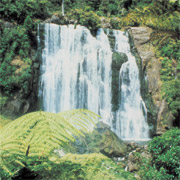New Plymouth to Auckland - Day One
New Plymouth to Taumarunui via the Forgotten Highway

It’s hard to leave New Plymouth with so much left to do. We’ve walked in Pukekura Park and visited the impressive rhododendron dells of Pukeiti, but the Sugar Loaf Islands Marine Park and the Taranaki Mineral Pools - where you can soak in 27,000-year-old thermal waters - remain outstanding.
“Never mind,” say Bob as we exit town on SH3 to Inglewood. “It’s always good to leave something to come back to.”
At Lake Mangamahoe we stop for a photo of Mt Taranaki’s reflection on the water’s tranquil surface before continuing to the outskirts of Inglewood, where we drive up the mountain through forest bearded densely with lichen and mosses to the Dept. of Conservation information centre. Its displays prove excellent – as do the views – and after soaking up the scenery we drive on to Stratford’s Clock Tower in time for the 10 am glockenspiel, where the tragedy of Shakespeare’s Romeo and Juliet unfolds to the peal of bells.
After enjoying a latté in the sun we leave town on SH43, or the Forgotten Highway as it’s more commonly known. Flanked by the railroad it’s a heritage trail that runs from Stratford to Taumarunui and has several attractions en route including a brick kiln and boarding house, a disused coalmine, coal seams on the roadside, old bridges and tunnels, riverboat landings and several Maori heritage sites.
We pass the rustic brick kiln and at Strathmore Saddle we stop to stretch our legs and admire the views of Mt Taranaki to the west, and Mt Tongariro, Mt Ruapehu and Mt Ngauruhoe to the east.
In Whangamomona there’s a pub, a café and a garage – and not a heck of a lot more at first glance. A guy in the garage gives us a friendly wave as we pass by.
“Let’s stop for lunch here,” says Bob pointing to M&M’s Café, housed in what was once the old Australasia bank. Inside we meet Marg – one of the M’s – her husband Mert, at the garage, is the other.
Within a short time we discover that this very small town has a very big heart. It’s also possibly the smallest fun ‘republic’ on earth. Marg fills us in: “Bureaucratic bungling in ’89 saw Whangamomona realigned with Whanganui instead of Taranaki and locals got a bit upset” she says, “A meeting in the pub resulted in them declaring it a republic.”
Nowadays they celebrate their independence day in January in style with presidential elections. Past presidents have included Billy Gumboot the goat, who ate the oppositions votes in the ‘99 election but died in active service (his gravesite is now a tourist attraction overlooking the main street) and Tai, a poodle, who was top dog until an assassination attempt left him in no mental state to rule!
In January 2005 Marg’s Mert became president and a crowd of over 4000 poured into town to take part in the celebrations.
“It was all on,” says Marg. “We had a sheep race down the main street, Clydesdale rides, shearing and chainsaw sculpting, wood chopping, and even an eel bath.”
“An eel bath?” enquiries Bob looking startled.
“Oh yes,” laughs Marg. “Some people squirmed but others seemed quite relaxed!”
Bob looks at me and shakes his head, and before we leave town we stick our heads into the pub and visit Billy Gumboot’s grave.
At the Damper Falls we hike to the 85 metre waterfalls which are said to be the highest in the North Island. They spill over a horseshoe-shaped bluff into a bush-fringed pool. “Spectacular,” is Bob’s only comment.
We drive through the Tangarakau Gorge’s magnificent podocarp forests to the Aukopae River Boat Landing, where riverboats landed cargoes of settlers, livestock and provisions before arriving in Taumarunui.
"Well," says Bob, after we’ve checked into our motel and sat down to a meal at a local restaurant, "It may be called the Forgotten Highway but I’m always going to remember that town!"